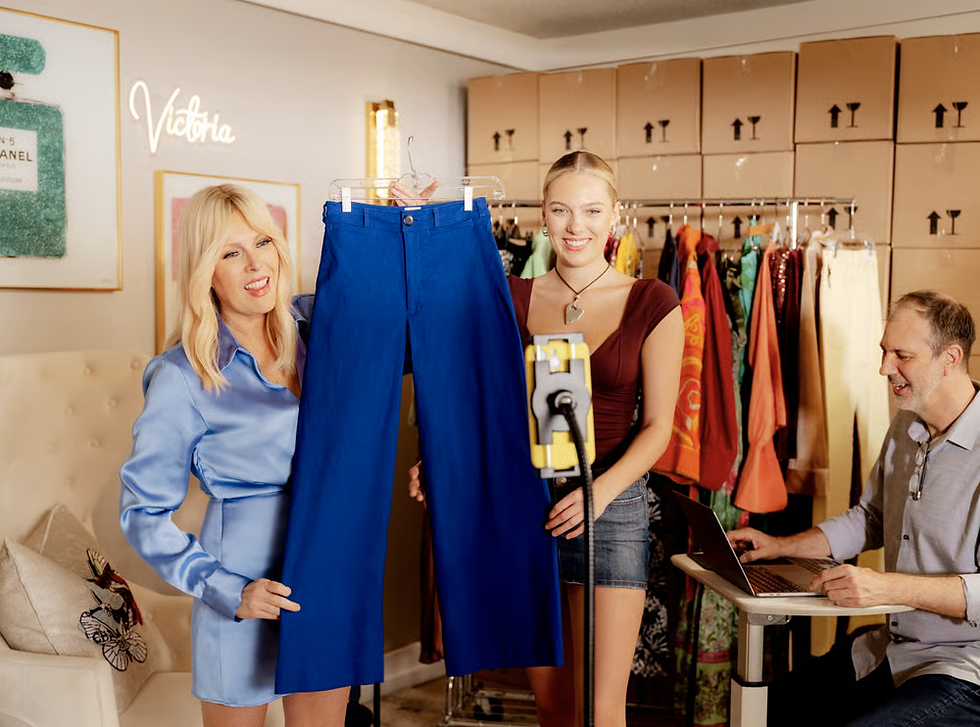Shopping: Millennial Money Moves: Nostalgia, Wellness & Convenience in 2025
- InsightTrendsWorld

- Aug 16
- 5 min read
Why It’s Trending: Redefining Purposeful Purchase Power
Millennials at Their Spending PeakMillennials (now aged 28–43) are in their prime earning and spending years. Many are well into careers, with dual-income households and children entering school. This places them in a position of immense consumer influence—both as direct buyers and as cultural gatekeepers shaping what becomes “mainstream.”
Shaped by Contrasting ErasThey grew up in a pre-digital world but entered adulthood during the tech explosion. They carry nostalgia for analog simplicity while being hyper-fluent in digital tools. Their buying habits reflect this blend—longing for childhood comfort while demanding seamless, tech-enabled shopping experiences.
A Generation Scarred by RecessionComing of age during the 2008 financial crash made millennials deeply cautious. Value-consciousness is ingrained, but unlike Gen Z’s bargain-first mentality, millennials balance cost with quality, durability, and emotional payoff.
Identity-Driven PurchasingUnlike earlier eras where consumption was about status symbols, millennials are far more likely to seek purchases that reflect personal values, stories, and identity markers. Buying is both an expression of who they are and an investment in who they aspire to be.
Overview: Purpose Meets Practicality
Millennials are deliberate consumers. They don’t just buy—they curate. Every purchase is filtered through the lens of meaning, convenience, wellness, and nostalgia. At the same time, they are busy—balancing demanding careers, parenting, and financial goals—so purchases must also deliver time-saving convenience.
They want efficiency without losing the emotional spark. A subscription box that delivers organic snacks, a retro brand reinvented with healthier ingredients, or a streamlined mobile shopping app all appeal to their dual desires for ease and depth.
Detailed Findings: Key Patterns in Millennial Buying
Nostalgia with a Modern TwistMillennials crave products that remind them of their childhood—think cereals, snack foods, or toys—but with an updated emphasis on cleaner ingredients, better sourcing, and premium design. Nostalgia is not about reliving the past exactly as it was, but about elevating it to fit their adult lifestyle and parental responsibilities.
Convenience as a Non-NegotiableTime is the scarcest resource for millennials. Between careers and raising young families, they prioritize frictionless shopping. Features like one-click checkout, seamless returns, and rapid delivery aren’t luxuries—they are expected. When faced with a choice between ethical considerations and convenience, many lean toward convenience first.
Wellness and Longevity InvestmentsMillennials have normalized self-care spending. From skincare to fitness apps, vitamins, and therapy, wellness is an ongoing investment rather than an occasional treat. Unlike Gen Z, who see wellness as part of aesthetics and social media identity, millennials see it as sustainability of body and mind for the long haul. Many would trade higher salaries for improved quality of life, highlighting a mindset shift toward health over hustle.
Breaking Taboos Through ConsumptionThis generation is also more willing to purchase items once considered “taboo” or niche—like plant-based proteins, alternative health remedies, sexual wellness products, and eco-friendly household solutions. Their buying choices help normalize previously marginalized categories and drive them into the mainstream.
Subscription as Lifestyle ArchitectureMillennials are the subscription pioneers—from streaming services to meal kits, subscription-based fashion, coffee, and pet products. They see subscriptions as not only convenient but also curated enhancements of lifestyle. These systems help reduce decision fatigue, turning routine shopping into predictable, automated rituals.
Key Success Factors Behind Millennial Loyalty
Emotional Resonance – Products need a story, not just a function.
Ease of Access – Time-saving digital infrastructure is key.
Self-Investment – Purchases must improve wellness, lifestyle, or family life.
Category Courage – They reward brands that innovate in once-taboo areas.
Routine + Ritual – Subscriptions provide a sense of order and reliability.
Key Takeaway: Curation Over Consumption
Millennials don’t see themselves as consumers but as curators of their lives. Their buying decisions are carefully woven into the narratives of who they are—parents, professionals, wellness seekers, nostalgic dreamers. They avoid clutter but embrace purchases that carry personal or cultural weight.
Main Trend: Value-Aligned Consumption
Millennials are steering an economy of values-driven shopping. It’s not about quantity or flash; it’s about authentic alignment with lifestyle needs, ethical considerations, and meaningful experiences.
Description of the Trend: “Conscious Convenience”
Millennial buying behavior in 2025 can be summed up as Conscious Convenience—the seamless blending of effortless purchasing with intentionality, where ease and values meet.
Key Characteristics of the Core Trend
Nostalgic Products Reimagined – Beloved brands revived with clean, premium updates.
Frictionless Journeys – Instant checkout, hassle-free returns, and digital-first retail.
Wellness as Priority – Health, beauty, and fitness positioned as essentials.
Bold Category Adoption – Openness to alternative and taboo products.
Subscription as Structure – Predictable, curated supply systems embedded in routine.
Market and Cultural Signals
Nostalgia marketing campaigns (retro cereals, reissued sneakers, 90s-inspired fashion) performing strongly with millennials.
Growth in direct-to-consumer wellness brands targeting 30–40-year-olds with skincare, supplements, and holistic health offers.
Subscription economy booming—millennials drive demand for meal kits, personal styling, kids’ activity boxes, and coffee delivery services.
Evidence of shifting brand loyalty: millennials are less tied to legacy names unless those brands innovate in authenticity, sustainability, and storytelling.
What Is Consumer Motivation
Desire to reconnect with comforting memories in modern, healthier ways.
Time scarcity—products must simplify life.
Self-preservation and longevity through health and wellness.
Identity expression—buying to align with who they are and want to be.
What Is Motivation Beyond the Trend
To construct stability in a chaotic, digitally saturated world.
To balance pragmatism with pleasure, integrating small joys into responsible budgets.
To teach values through purchases, as many are now raising Gen Alpha children.
Descriptions of Consumers: The Millennial Curators
Who They Are: Adults 28–43, balancing careers, parenthood, and personal growth.
Income: Middle to upper-middle earners; a notable minority earning six figures.
Lifestyle: Hybrid digital natives—tech-savvy but nostalgic. Highly scheduled.
Mindset: Value-conscious, authenticity-driven, wellness-oriented.
Behavior: Subscription adopters, convenience seekers, nostalgic buyers, cautious yet emotionally engaged spenders.
How the Trend Is Changing Consumer Behavior
Shopping is more intentional, less impulsive.
Legacy brands are pressured to adapt to cleaner, more authentic narratives.
Millennials are teaching Gen Alpha consumption values—embedding wellness, digital literacy, and ethical shopping.
Implications Across the Ecosystem
For Consumers: More time-efficient and meaningful shopping experiences.
For Brands: Storytelling, nostalgia, and wellness must anchor strategies.
For Retailers: Subscriptions, omnichannel access, and convenience-first design are crucial.
Strategic Forecast
Short-Term (1–2 years): Retro revivals (90s/2000s brands) with health-forward reformulations.
Mid-Term (3–5 years): Subscription ecosystems that personalize offerings (AI-driven curation for food, wellness, and family products).
Long-Term (5–10 years): Brands shift from selling products to selling life frameworks—ecosystems that manage health, convenience, and identity seamlessly.
Areas of Innovation
Retro-Remixed Brands – Nostalgic classics reformulated for wellness and clean labels.
AI-Enhanced Subscriptions – Personalized, adaptive deliveries aligned to changing family needs.
Wellness-as-Routine Products – Embedding self-care into everyday consumption, from functional drinks to holistic health kits.
Bold New Categories – Growth in sexual wellness, plant-based lifestyles, and alternative therapies.
Curated Digital Experiences – Retail experiences blending convenience with storytelling, such as gamified shopping apps.
Summary of Trends
Core Consumer Trend: Conscious Convenience—purchases that save time and align with values.
Core Social Trend: Wellness as Cultural Capital.
Core Strategy: Curation > Consumption—life design over product accumulation.
Core Industry Trend: Subscription Economy as Standard.
Core Motivation: To balance nostalgia, convenience, and wellbeing in a purposeful way.
Final Thought: Curators, Not Consumers
Millennials in 2025 are not passive buyers. They are active curators of identity, wellness, and lifestyle. They purchase with intention, blending nostalgia with innovation, and convenience with consciousness. To win their loyalty, brands must go beyond selling products—they must deliver meaning, time efficiency, and trust.





Comments